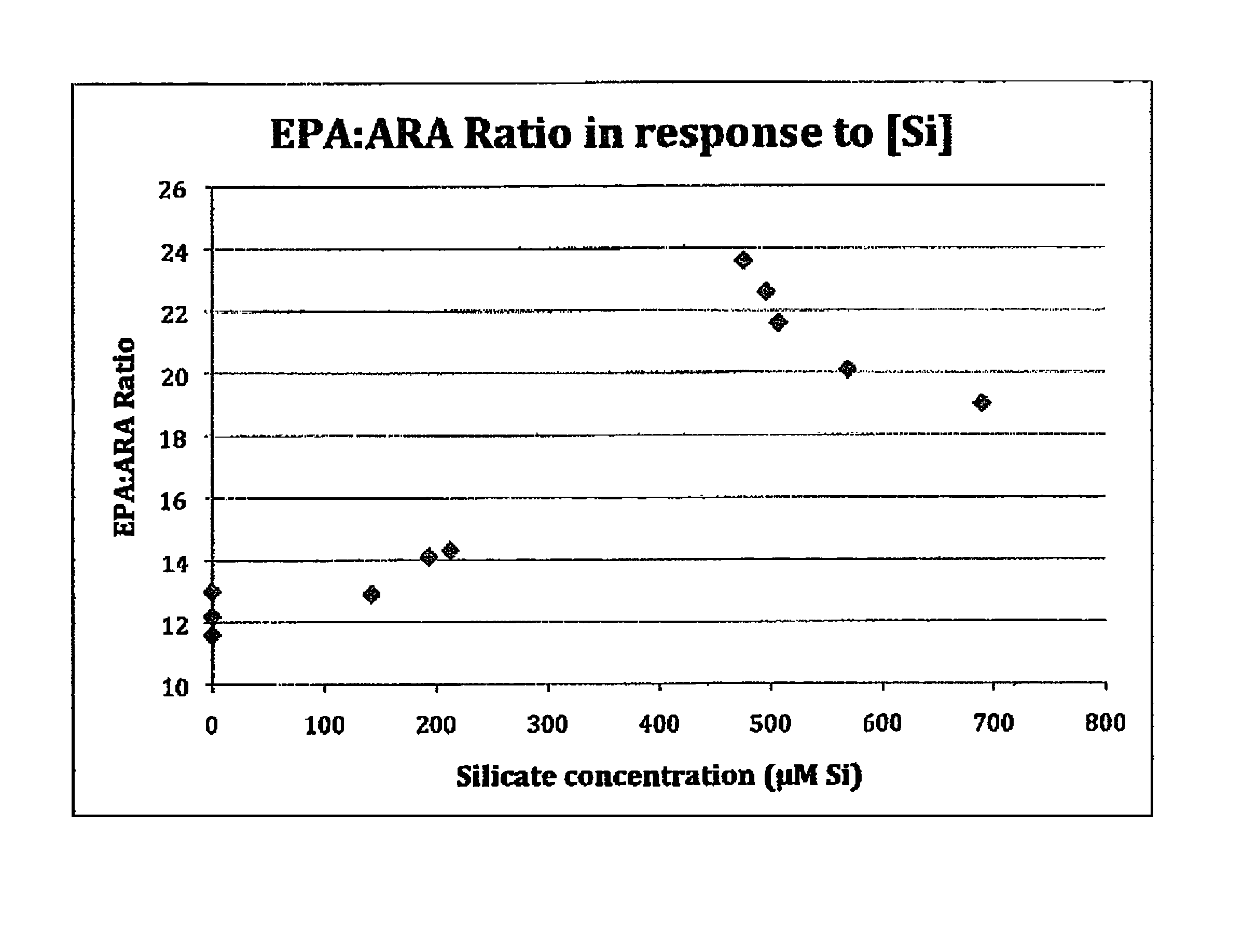Compositions comprising eicosapentaenoic acid suitable for high purification
a technology of eicosapentaenoic acid and high purification, which is applied in the direction of anhydride/acid/halide active ingredients, biocide, microorganisms, etc., can solve the problems of limiting the use of fish oil for such purposes, unable to chemically synthesize de, and unable to meet the requirements of eicosapentaenoic acid synthesis, etc., to achieve the effect of reducing the number o
- Summary
- Abstract
- Description
- Claims
- Application Information
AI Technical Summary
Benefits of technology
Problems solved by technology
Method used
Image
Examples
example 1
[0239]3 g (dry weight) of a Nitzschia laevis strain In1 culture was transferred into a stirred tank fermenter with a working volume of 19.4 L. The vessel contained growth media with salts and vitamins as detailed in table 1 together with nutrients at concentrations of: 30 g / L glucose, 1.2 g / L yeast extract, 1.3 g / L sodium nitrate, 40 mg / L potassium dihydrogen phosphate and 270 mg / L sodium metasilicate pentahydrate.
[0240]
TABLE 1Salt and vitamin content of fermenter mediaNaCl136.9 mMMgSO4*7H2O8.9 mMKCl7.2 mMCaCl20.9 mM(NH4)6Mo7O24*4H2O2.2 μMCoCl2*6H2O1.0 μMMnCl2*4H2O12.6 μMNa2MoO4*2H2O1.0 μMH3BO34.9 μMZnCl222.8 μMFeCl3•6H2O8.1 μMNa2EDTA72.5 μMVitamin B1260 mg / LThiamine100 mg / LBiotin100 mg / L
[0241]The culture was aerated with one vessel volume of sterile air per minute and agitation controlled to give a dissolved oxygen content of >50%. pH was maintained at 8.0 by the addition of 0.4 N NaOH. Temperature was maintained at 20° C. by the circulation of hot or cold water through a jacket ar...
example 2
[0252]3 g (dry weight) of a Nitzschia laevis strain In1 culture was transferred into a stirred tank fermenter with a working volume of 18 L. The vessel contained growth media with salts and vitamins as detailed in table 1 together with nutrients at concentrations of: 30 g / L glucose, 1.6 g / L yeast extract, 2.98 g / L sodium nitrate, 80 mg / L potassium dihydrogen phosphate and 270 mg / L sodium metasilicate pentahydrate.
[0253]The culture was aerated with one vessel volume of sterile air per minute and agitation controlled to give a dissolved oxygen content of >50%. pH was maintained at 8.0 by the addition of 0.4 N NaOH. Temperature was maintained at 20° C. by the circulation of hot or cold water through a jacket around the fermenter vessel as required.
[0254]Attached to the reactor was a settling device designed to separate media from cells. Culture was pumped into the device and cells were returned to the main fermenter vessel whilst spent media could be drawn off to waste. Fresh sterile m...
example 3
[0260]3 g (dry weight) of a Nitzschia laevis strain In1 culture was transferred into a stirred tank fermenter with a working volume of 14 L. The vessel contained growth media with salts and vitamins as detailed in table 1 together with nutrients at concentrations of: 50 g / L glucose, 1.9 g / L yeast extract, 4.0 g / L sodium nitrate, and 170 mg / L potassium dihydrogen phosphate. Sodium metasilicate pentahydrate was added separately as a concentrated stock to a concentration of 143 mg / L.
[0261]The culture was aerated with one vessel volume of sterile air per minute and agitation controlled to give a dissolved oxygen content of >50%. pH was maintained at 8.0 by the addition of 0.4 N NaOH. Temperature was maintained at 20° C. by the circulation of hot or cold water through a jacket around the fermenter vessel as required.
[0262]The media contained a molar ratio C:N of less than 30:1 (see table 6) so as to avoid nitrogen limitation. All measurements of levels in harvested media confirmed that t...
PUM
| Property | Measurement | Unit |
|---|---|---|
| temperature | aaaaa | aaaaa |
| molar ratio | aaaaa | aaaaa |
| yield rate | aaaaa | aaaaa |
Abstract
Description
Claims
Application Information
 Login to View More
Login to View More - R&D
- Intellectual Property
- Life Sciences
- Materials
- Tech Scout
- Unparalleled Data Quality
- Higher Quality Content
- 60% Fewer Hallucinations
Browse by: Latest US Patents, China's latest patents, Technical Efficacy Thesaurus, Application Domain, Technology Topic, Popular Technical Reports.
© 2025 PatSnap. All rights reserved.Legal|Privacy policy|Modern Slavery Act Transparency Statement|Sitemap|About US| Contact US: help@patsnap.com

